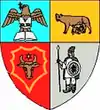Năsăud
Năsăud (Romanian pronunciation: [nəsəˈud]; German: Nassod, Nußdorf; Hungarian: Naszód) is a town in Bistrița-Năsăud County in Romania located in the historical region of Transylvania. The town administers two villages, Liviu Rebreanu (formerly Prislop; Priszlop) and Lușca (Szamospart). At the 2011 census, 93.6% of inhabitants were Romanians, 5.5% Roma and 0.6% Hungarians.
Năsăud | |
|---|---|
.jpg.webp) Năsăud town hall | |
 Coat of arms | |
 Location in Bistrița-Năsăud County | |
 Năsăud Location in Romania | |
| Coordinates: 47°17′0″N 24°24′24″E | |
| Country | |
| County | Bistrița-Năsăud |
| Government | |
| • Mayor | Mircea Romocea[1] (PSD) |
| Area | 43.25 km2 (16.70 sq mi) |
| Population (2011)[2] | 9,587 |
| • Density | 220/km2 (570/sq mi) |
| Time zone | EET/EEST (UTC+2/+3) |
| Vehicle reg. | BN |
| Website | www |
History
| Year | Pop. | ±% |
|---|---|---|
| 1930 | 3,512 | — |
| 1948 | 3,716 | +5.8% |
| 1956 | 5,725 | +54.1% |
| 1966 | 6,620 | +15.6% |
| 1977 | 8,610 | +30.1% |
| 1992 | 12,176 | +41.4% |
| 2002 | 11,365 | −6.7% |
| 2011 | 9,077 | −20.1% |
| Source: Census data | ||
The name Năsăud is possibly derived from the Slavic nas voda, meaning "near the water". Another etymology is from Nußdorf (Nussdorf, "walnut tree village"), the Transylvanian Saxon name of the town during the Middle Ages. However, it derived from a person name, documented in 1269 as Naswod (current Nesvady).
A former Habsburg border town known for its border regiments with panache and good schools, Năsăud saw industrial expansion during the communist era and industrial collapse after 1989. Local economic activity revolves around the remittance economy generated by massive outmigration to Spain and Italy during the early 2000s, although the largest industrial employers in textiles and chemicals have been rejuvenated by EU membership.
Năsăud still has a few late 18th and early 19th century buildings left standing. Most remarkable in this regard is the local Romanian Greek Catholic church and the former military headquarters of the Habsburg era military regiment, now a museum. Although the town hall is located in its midst, the 19th century center of the town has been left to decay. Since 2012 the municipality has begun to restore the buildings in the old city center. The town hall saw a complete restoration and expansion in 2013.
The economic upturn of the mid-2000s has translated into a better city life and infrastructure improvements. Most notable in this regard are the refurbishing of the old military headquarters (now a museum), improved roads and more bar/restaurant options. Two new restaurants (Geea and La Borsanu) are popular in town.
Natives
- Joel Brand (1906–1964), member of the Budapest Aid and Rescue Committee during the Holocaust
- Tudor Bompa (born 1932), sports scientist, professor at York University
- Nicolae Bretan (1887–1968), opera composer, baritone, conductor, and music critic
- Vasile Dîncu (born 1961), politician
- Tudor Drăganu (1912–2010), jurist
- Veronica Micle (1850–1889), poet, best known for her love affair with Mihai Eminescu
- Constantin C. Moisil (1876–1958), archivist, historian, numismatist, and schoolteacher
- Iuliu Moisil (1859–1947), schoolteacher and non-fiction writer
Photo gallery
 Entrance from the west
Entrance from the west View from the east
View from the east Train station
Train station Towers of the Romanian Greek-Catholic church
Towers of the Romanian Greek-Catholic church Monument in the park
Monument in the park Romanian Orthodox church
Romanian Orthodox church
Notes
| Wikimedia Commons has media related to Năsăud. |
- "Results of the 2016 local elections". Central Electoral Bureau. Retrieved 3 April 2020.
- "Populaţia stabilă pe judeţe, municipii, oraşe şi localităti componenete la RPL_2011" (in Romanian). National Institute of Statistics. Retrieved 4 February 2014.
